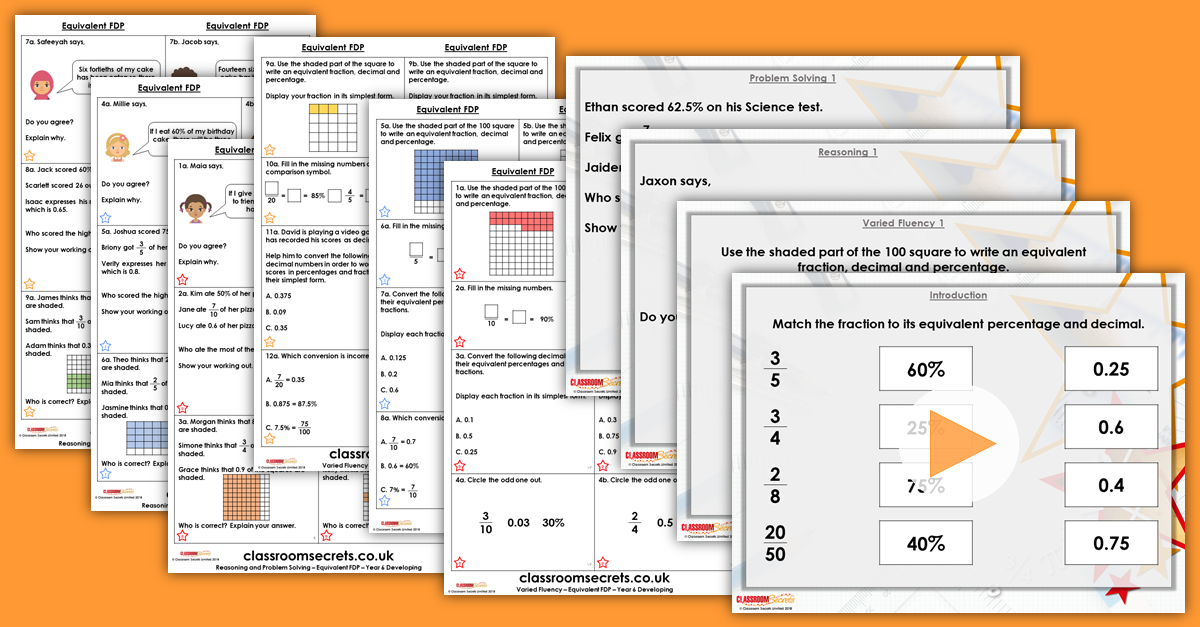Equivalent FDP Year 6 Percentages Resource Pack
Step 2: Equivalent FDP Year 6 Spring Block 2 Resources
Equivalent FDP Year 6 Resource Pack includes a teaching PowerPoint and differentiated varied fluency and reasoning and problem solving resources for Spring Block 2.
Not a member? Sign up here.
What's included in the pack?
This pack includes:
- Equivalent FDP Year 6 Teaching PowerPoint.
- Equivalent FDP Year 6 Varied Fluency with answers.
- Equivalent FDP Year 6 Reasoning and Problem Solving with answers.
National Curriculum Objectives
Mathematics Year 6: (6F6) Associate a fraction with division and calculate decimal fraction equivalents [for example, 0.375] for a simple fraction [for example, 3/8]
Mathematics Year 6: (6F11) Recall and use equivalences between simple fractions, decimals and percentages, including in different contexts
Differentiation For Equivalent FDP Year 6:
Varied Fluency
Developing Questions to support finding equivalent fractions, decimals and percentages. Using hundredths, tenths, quarters and halves. Fractions may need to be simplified.
Expected Questions to support finding equivalent fractions, decimals and percentages. Using fifths, eighths, tenths, hundredths, quarters and halves. Fractions may need to be simplified.
Greater Depth Questions to support finding equivalent fractions, decimals and percentages. Using fifths, eighths, tenths, twentieths, hundredths, quarters and halves, or multiples of these fractions. Fractions may need to be simplified.
Reasoning and Problem Solving
Questions 1, 4 and 7 (Reasoning)
Developing Explain why a statement is correct or incorrect. Using tenths, quarters or halves.
Expected Explain why a statement is correct or incorrect. Using fifths, eighths, tenths, hundredths, quarters or halves. Fractions may need to be simplified.
Greater Depth Explain why a statement is correct or incorrect. Using fifths, eighths, tenths, twentieths, quarters or halves, or multiples of these fractions. Fractions may need to be simplified.
Questions 2, 5 and 8 (Problem Solving)
Developing State which is the largest value. Using tenths, quarters or halves.
Expected State which is the largest value. Using fifths, eighths, tenths, hundredths, quarters or halves. Fractions may need to be simplified.
Greater Depth State which is the largest value. Using fifths, eighths, tenths, twentieths, quarters or halves, or multiples of these fractions. Fractions may need to be simplified.
Questions 3, 6 and 9 (Reasoning)
Developing Explain which statement is correct. Using tenths, quarters or halves.
Expected Explain which statement is correct. Using fifths, eighths, tenths, hundredths, quarters or halves. Fractions may need to be simplified.
Greater Depth Explain which statement is correct. Using fifths, eighths, tenths, hundredths, twentieths, quarters or halves, or multiples of these fractions. Fractions may need to be simplified.
This resource is available to download with a Premium subscription.








